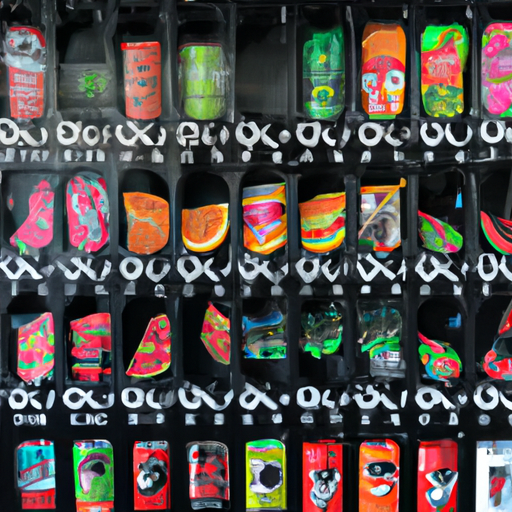Have you ever wondered how often drink vending machines need to be restocked? We all rely on them for our daily dose of refreshment, whether it’s grabbing a soda on our lunch break or quenching our thirst during a long road trip. But have you ever stopped to think about the behind-the-scenes work that goes into ensuring these machines are always filled and ready for us? In this article, we will explore the frequency at which drink vending machines require restocking and the factors that contribute to their replenishment needs. So, grab your favorite beverage, sit back, and let’s dive into the fascinating world of drink vending machines!
Factors Affecting Restocking Frequency
Demand for Beverages
The demand for beverages is one of the key factors that affect restocking frequency. If the vending machine is located in a high-traffic area with a constant flow of customers, the demand for beverages will be higher, resulting in more frequent restocking. On the other hand, if the vending machine is situated in a less busy area, the demand may be lower, leading to less frequent restocking.
Location of the Vending Machine
The location of the vending machine plays a vital role in determining restocking frequency. Vending machines placed in prime locations such as malls, schools, or office buildings are likely to experience higher foot traffic and consequently, increased demand for beverages. As a result, these vending machines will require more frequent restocking compared to those located in less bustling areas.
Vending Machine Capacity
The capacity of the vending machine is another factor that influences restocking frequency. Vending machines with larger storage capacities can hold a greater quantity of beverages, thereby reducing the need for frequent restocking. Conversely, vending machines with smaller capacity will require restocking at shorter intervals to ensure an uninterrupted supply of beverages.
Time of Year
The time of year can also impact restocking frequency. During certain seasons or holidays, the demand for certain beverages may increase, resulting in the need for more frequent restocking. For example, during the summer months, the demand for cold beverages like iced tea or soda may be higher, necessitating more regular restocking to meet customer needs.
Type of Beverages Offered
The type of beverages offered in the vending machine can affect restocking frequency as well. If the vending machine primarily offers popular and widely consumed drinks, the demand for these beverages is likely to be higher, leading to more frequent restocking. Conversely, if the vending machine offers niche or specialized beverages, the demand may be lower, resulting in less frequent restocking.
General Restocking Frequency
Average Restocking Intervals
The average restocking intervals for drink vending machines can vary depending on several factors. In high-demand locations, restocking may need to be done daily or even multiple times a day to ensure an uninterrupted supply of beverages. In moderate-demand areas, restocking intervals may range from every few days to once a week. In lower-demand locations, restocking intervals could be as infrequent as once every couple of weeks.
Variations in Restocking Frequency
It is important to note that restocking frequency is not always constant and can vary based on various factors. For instance, restocking may need to occur more frequently during peak hours or on certain days of the week when demand is higher. Additionally, unexpected events such as special events or promotions may increase demand and require additional restocking.
Inventory Management Techniques
Forecasting Demand
Forecasting demand is a crucial inventory management technique that can help optimize restocking frequency. By analyzing historical sales data, seasonality patterns, and external factors such as upcoming events, vending machine operators can make informed predictions about future demand. This allows them to plan restocking schedules more accurately and avoid stockouts or excess inventory.
Optimizing Route Planning
Efficient route planning can also contribute to effective inventory management and restocking frequency. By optimizing the route taken to restock vending machines, operators can minimize travel time and fuel costs. This optimization can help ensure that restocking is done in a timely manner, reducing the chances of beverage shortages and maximizing operational efficiency.
Machine Monitoring Systems
Machine monitoring systems can provide real-time data on the status of the vending machines, including the inventory levels. This information enables operators to remotely monitor the stock levels and proactively schedule restocking based on the actual demand. Machine monitoring systems help prevent stockouts and minimize unnecessary restocking trips, thereby improving overall efficiency.
Considerations for Vending Machine Operators
Cost of Restocking
Vending machine operators need to take into account the cost of restocking when determining the restocking frequency. Restocking involves expenses such as labor costs, transportation costs, and the cost of purchasing additional inventory. By carefully balancing the restocking frequency, operators can optimize costs and minimize unnecessary expenditures while maintaining the desired level of customer satisfaction.
Efficiency and Productivity
Efficiency and productivity are crucial considerations for vending machine operators. Restocking at the right frequency ensures that beverages are readily available to customers, reducing the chances of dissatisfied customers or lost sales opportunities. By implementing efficient restocking processes, operators can minimize downtime and make the most of the time spent on restocking activities.
Customer Satisfaction and Retention
Customer satisfaction and retention are paramount for vending machine operators. Regular and timely restocking ensures that customers always find their favorite beverages available, enhancing their overall experience. Satisfied customers are more likely to return to the vending machine, increasing the chances of repeat sales and fostering long-term customer loyalty.
Conclusion
Restocking frequency for drink vending machines is influenced by various factors such as the demand for beverages, location, machine capacity, time of year, and types of beverages offered. Vending machine operators can optimize restocking frequency by employing inventory management techniques like forecasting demand, optimizing route planning, and utilizing machine monitoring systems. Considerations such as cost, efficiency, and customer satisfaction play a vital role in determining the frequency and effectiveness of restocking. By carefully balancing these factors, vending machine operators can ensure a smooth and profitable operation while meeting customer expectations.
